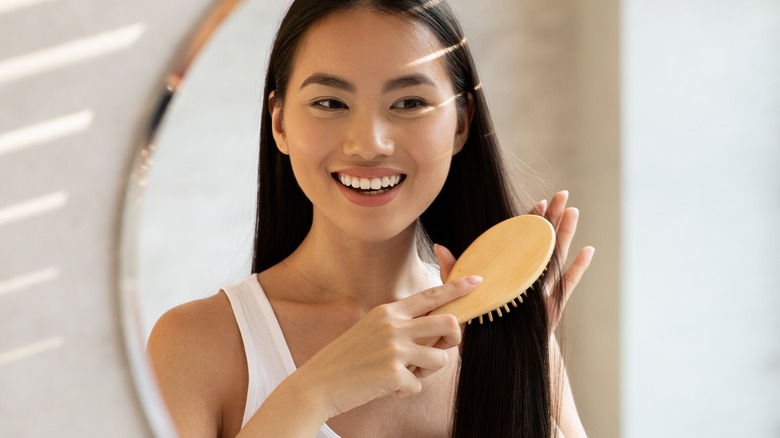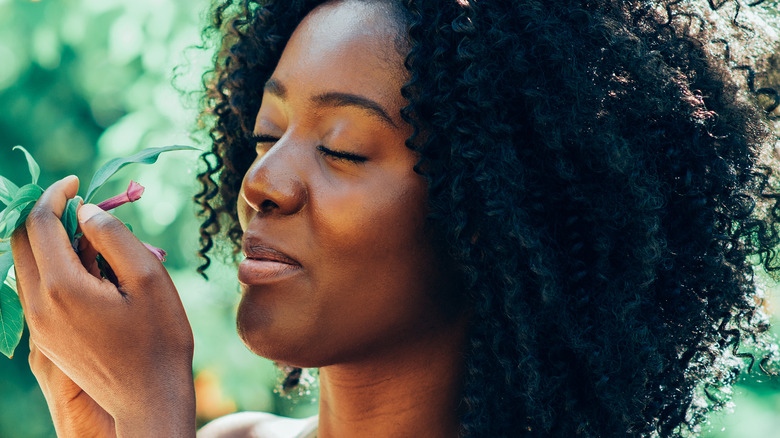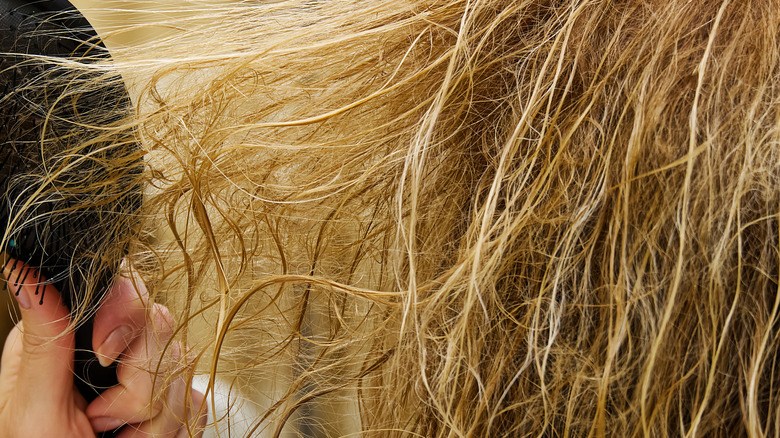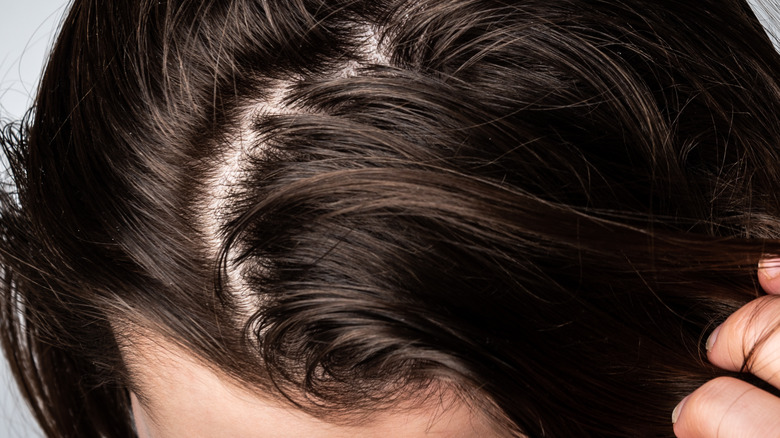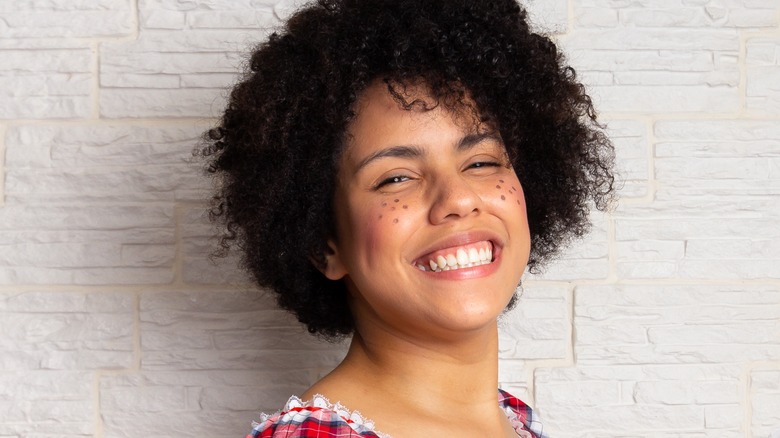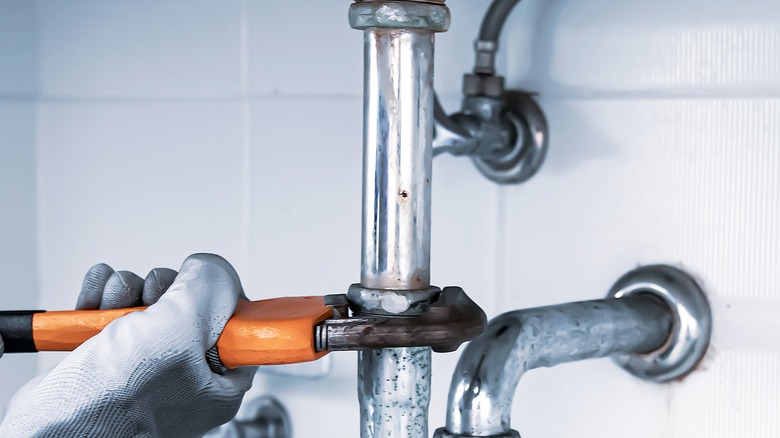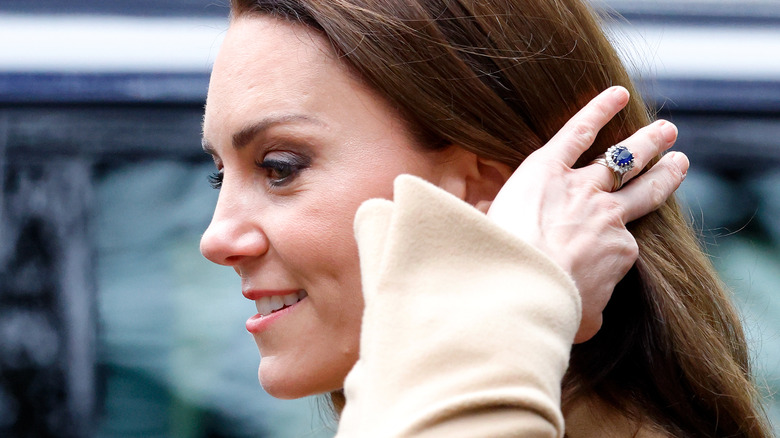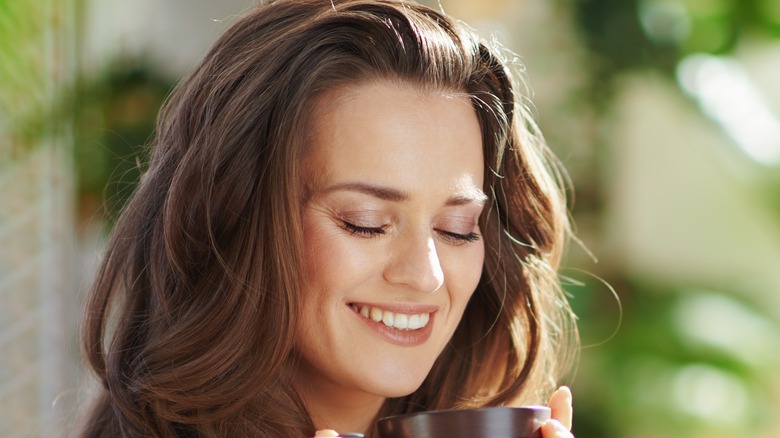Consequences Of Not Brushing Your Hair Anymore
We don't need a Ph.D. in haircare to know that brushing hair is an essential part of hair maintenance. When we were little, for many of us, our mothers would stoop down and gently comb our hair as they helped us get ready for school and for bed. Growing up, brushing hair easily becomes second nature to us — like flossing or our skincare regimens. And while hair brushing is often taught as a self-care necessity, there's a deeper drive to stroke our hair strands every day.
"Brushing hair is usually for two reasons: To detangle or to brush for shine and health," consultant trichologist David Adams tells Sunday Riley. "The sebaceous glands produce oil to lubricate the scalp and hair, brushing is a good way to distribute the natural oils through the hair to the ends, resulting in shiny hair after brushing." But, is it true that brushing your hair is a tried-and-true formula for healthy hair? According to a 2009 study published in the Journal of Dermatological Treatment, frequent hair brushing might contribute to increased hair loss, and by the same token hair loss can be reduced with reduced brushing frequency. So, what happens when we stop brushing our hair altogether?
You'll enjoy thicker hair
Skipping the brush might help you lose less hair and make the hair you have look thicker. "I am anti-brushing," says trichologist Philip Kingsley who took care of Audrey Hepburn's hair (via Daily Mail). "I have been for years, ever since I started doing research into the dust particles in hairbrushes and realized that a lot of it is actually hair broken by brushing and healthy cells that have been stripped off the scalp."
The idea that we should use 50 to 100 strokes of the brush every day, according to Kingsley, comes from a time when people didn't wash their hair, therefore brushing was necessary to remove dirt and pollutants. But we are living in the 21st century where we have access to a galore of deep-cleansing shampoos and advanced hair treatments that help keep our hair clean and nourished. Besides, when you brush your hair, vigorous pulling and twisting might weaken parts of the cuticles and cause hair thinning.
That said, there's no conclusive evidence that brushing your hair is bad for the hair. As long as you use the right brushing product and the right technique, brushing should be a damage-free experience. "The classic technique of brushing hair — head down, bending from the waist, slowly and gently brush from the nape of the neck, up through the sides of the crown, slowly working to the front of the head. Then, stand up straight and repeat the whole process — is best," consultant trichologist David Adams tells Sunday Riley.
Tangled hair is a given
Brushing helps to detangle knots in your hair. When you stop combing through your hair to break up knots, you'll start noticing tangles. However, your risks of getting tangles and knots in the hair after ditching the brush also has a lot to do with your hair type. "Tangling is more common in dry and damaged hair because the cuticles don't lie flat, which allows strands to snag against each other and become intertwined," dermatologist Iris Rubin tells Byrdie.
If your hair is prone to dryness and knots, you might have to enlist the help of a brush while in the shower to help prevent tangling. Before rinsing conditioner off your hair, use a wide-tooth comb to gently release knots and tangles without extra snagging or pulling on the hair. According to Rubin, combing your hair while the conditioner is still in it increases the hair's elasticity, reducing breakage and damage to the hair. Or, you can spritz detangling spray to your dry or damp hair and brush the knots out with a comb.
Your hair gets greasy faster
When you stop running a hairbrush through your tresses daily, you'll notice more oil buildup at your roots and your hair gets greasier faster because of that. Brushing your hair stimulates oil production, which helps even out the amount of sebum that builds up in your hair follicles through the hair to the ends, giving your tresses a natural shine. When you stop brushing your hair, the opposite happens — the hair ends are unable to receive that natural oil at the hair root, and you'll notice extra greasiness at the roots as a result.
If your hair gets greasy faster than usual and you don't want to get back to using a hairbrush soon, use a dry shampoo as a way to keep your hair fresh and vibrant between washes. Dry shampoo is a type of water-free hair cleanser and is able to remove excess oil, grease, and impurities from your hair without the need of a wash, according to Pantene. However, you need to cleanse your scalp thoroughly after using dry shampoo to remove all the product residues.
Your hair might look dry and frizzy
Aside from making your hair look tangled and greasy, the absence of a brush on your locks can also cause your hair to look frizzy and dry, hairstylist and salon owner Mark Anthony Rosales tells Cosmopolitan. Actually, overbrushing your hair or using the wrong brush on your strands can also affect your cuticles and contribute to frizz. If your hair is prone to frizziness, brushing it will evenly distribute the natural oils on your scalp, hydrating your strands and kipping frizz at bay, per ETE Saigon – Hair Happiness.
To smooth out frizz, choose a wide-tooth comb to brush your hair when it's still damp, hair stylist Josh Shellhammer tells John Frieda. Because they have more space for individual strands, which is helpful in minimizing hair breakage, they are better for the hair. Another tip he has for those who do use a hairbrush — "Wash your brush with a mild shampoo at least once every couple weeks," he explains. "There can be fuzzies that get trapped in the bristles that can get into the hair."
You'll have more plumbing issues
If you stop brushing your hair, you'll start noticing more hair infiltrating your shower drain. According to the American Academy of Dermatology Association, a person sheds about 50 to 100 strands of hair strands every day. Brushing your hair helps to remove this ready-to-shed hair that may otherwise fall out as you're washing your hair in the shower, on your bedsheets, or all over your floor. Wouldn't it be easier to collect fallen hair on your hairbrush rather than picking them from the floor or the shower drain every day?
If you want to forego the hairbrush and run into a plumbing issue, one simple way to clear up blockage at the drain, according to Ricks Plumbing, is to mix baking soda with vinegar. Then, flush the mixture down the drain along with some water to break up the sticky goop in the drain. After five minutes, pour some boiling hot water down the drain to clear up the clog. For stubborn drain clogs that cannot be dissolved easily with baking soda, you may want to use a plunger or a snaking tool to draw the clogged hair out of the pipe.
You'll develop the habit of using your hands to brush your hair
If you don't use a hairbrush and your hair gets tangled at some point, you'll naturally use your fingers to work out the knots in your hair. And this type of brushing boasts plenty of benefits for your hair. According to Odele, running your fingers through your tresses to detangle knots is a far gentler and safer method for detangling compared to using a regular brush, which can potentially cause mechanical stress on the hair with all the pulling and tugging. Using your own hands to detangle knots in your hair also allows you greater control and accuracy over the handling of a really tricky hair knot that could not be simply smoothed away with bristles. You know when to gather force, adjust pressure, and gentle work your knots apart.
When it comes to detangling, Odele suggests doing it on wet or damp hair, which is when it becomes more elastic and less prone to breakage. You can add some moisturizing leave-in conditioner or regular conditioner to your hair to make it easier to loosen and separate the knots.
You'll have more difficulties with styling
Completely ditching the brush might make your hair styling process more challenging. According to L'Oréal Paris, brushing your hair aids tremendously in styling and is essential for pulling your hair together. The key to having beautifully groomed hair is utilizing a brush, whether you're smoothing your strands into a half-up hairstyle or combing them back into a slicked-back 'do, according to the site. In addition to that, brushing your hair also helps to place your hair strands in the appropriate directions, making your styling much more convenient.
You may still comb through and style your hair with your fingers, though. By running your fingers through your hair and doing some shaking at the roots as you blow dry, you can create a windblown tousled hairstyle, according to Brunette on a Mission. Then, add some styling foam to damp hair, working it through to the hair ends with your fingers to give your hair more volume and lift.
